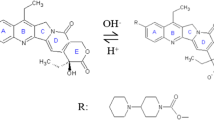Abstract
Background
Currently, treatment of malignant gliomas with temozolomide in addition to surgical resection and radiotherapy remains the foundation of glioma therapy. In an effort to develop new therapeutic choices to treat malignant gliomas, we have designed slow-releasing microspheres that deliver temozolomide (P-TMZ). The local continuous release of temozolomide at the intracranial tumor site may overcome many obstacles associated with systemic delivery, which will help to further improving the therapeutic effects against malignant gliomas.
Methods
Slow-releasing microspheres containing 10 % temozolomide were prepared, the antitumor efficacy in vitro was evaluated with MTT assay, and the therapeutic efficacy in vivo against gliomas was assessed in human glioma (SGH44) nude mice s.c. and orthotopic xenograft models.
Results
A single local injection of P-TMZ led to significant reduction both in s.c. and orthotopic human SHG44 glioma xenografts. P-TMZ, BCNU and TMZ had significant antiglioma effect (P < 0.01), their IC50 value was all less than 10 μg/ml. Tumor inhibition ratio of P-TMZ, BCNU and TMZ in vivo was higher than empty microspheres P0 (P < 0.01); P-TMZ and BCNU showed higher antitumor efficacy than TMZ (P < 0.05).
Conclusions
Our present results suggest that local delivery of slow-releasing temozolomide microspheres is effective for malignant gliomas. P-TMZ retained good antitumor activity and had better therapeutic effect against glioma both in vitro and in vivo, which provide a new choice for future clinical interstitial chemotherapy.



Similar content being viewed by others
References
Banissi C, Ghiringhelli F, Chen L, Carpentier AF (2009) Treg depletion with a low-dose metronomic temozolomide regimen in a rat glioma model. Cancer Immunol Immunother 58(10):1627–1634
Dong J, Zhang Q, Huang Q, Chen H, Shen Y, Fei X et al (2010) Glioma stem cells involved in tumor tissue remodeling in a xenograft model. J Neurosurg 113(2):249–260
Fei XF, Zhang QB, Dong J, Diao Y, Wang ZM, Li RJ et al (2010) Development of clinically relevant orthotopic xenograft mouse model of metastatic lung cancer and glioblastoma through surgical tumor tissues injection with trocar. J Exp Clin Cancer Res 29:84
Fleming AB, Saltzman WM (2002) Pharmacokinetics of the carmustine implant. Clin Pharmacokinet 41(6):403–419
Hart MG, Grant R, Garside R, Rogers G, Somerville M, Stein K (2011) Chemotherapy wafers for high grade glioma. Cochrane Database Syst Rev 3:CD007294
Holdhoff M, Grossman SA (2011) Controversies in the adjuvant therapy of high-grade gliomas. Oncologist 16(3):351–358
Li XN, Du ZW, Huang Q, Wu JQ (1997) Growth-inhibitory and differentiation-inducing activity of dimethylformamide in cultured human malignant glioma cells. Neurosurgery 40(6):1250–1258 (discussion 1258–1259)
Tomayko MM, Reynold CP (1989) Determination of subcutaneous tumor size in athymic (nude) mice. Cancer Chemother Pharmacol 24:148–154
Valtonen S, Timonen U, Toivanen P, Kalimo H, Kivipelto L, Heiskanen O et al (1997) Interstitial chemotherapy with carmustine-loaded polymers for high-grade gliomas: a randomized double-blind study. Neurosurgery 41(1):44–48 (discussion 48–49)
Whittle IR, Lyles S, Walker M (2003) Gliadel therapy given for first resection of malignant glioma: a single centre study of the potential use of Gliadel. Br J Neurosurg 17(4):352–354
Zhang H, Gao S (2007) Temozolomide/PLGA microparticles and antitumor activity against glioma C6 cancer cells in vitro. Int J Pharm 329(1):122–128
Acknowledgments
This study was supported by National Natural Science Foundation of China (No. 81071766) and Natural Science Foundation of Jiangsu Province, China (BK2010227). We thank Dr. Hailong Yang (Chemical Medicine Laboratory, Tianjin Tasly Institute, Tianjin, 300402, China) for kindly offering TMZ and slow-releasing temozolomide microspheres.
Conflict of interest
The authors report no conflict of interest concerning the materials or methods used in this study or the findings specified in this paper.
Author information
Authors and Affiliations
Corresponding author
Rights and permissions
About this article
Cite this article
Dong, J., Zhou, G., Tang, D. et al. Local delivery of slow-releasing temozolomide microspheres inhibits intracranial xenograft glioma growth. J Cancer Res Clin Oncol 138, 2079–2084 (2012). https://doi.org/10.1007/s00432-012-1290-3
Received:
Accepted:
Published:
Issue Date:
DOI: https://doi.org/10.1007/s00432-012-1290-3




